Feasibility and Techno-Economic Evaluation of Hybrid Photovoltaic System: A Rural Healthcare Center in Bangladesh
Abstract
:1. Introduction
2. Research Methodology
2.1. Site Selection
2.2. System Optimization Tool
2.3. Design Specifications
3. Results and Discussion
3.1. Estimation of Load Requirements
3.2. Load Profile
3.3. Solar Energy Resources
3.4. Optimization Results
3.5. Payback Period Calculation
4. Conclusions
- The grid/PV/generator system was the best combination with the lowest net present cost, because the electricity production cost of the studied system was $0.06/kWh; this was significantly lower than today’s average per-unit cost of $ 0.092 in Bangladesh. Moreover, it had a net present cost of $28,705 and a levelized cost of electricity per kWh of $0.02738.
- In this system, the total electricity production of the hybrid PV system was 912,158.56 kWh in 25 years, whereas the selected health care center might need 612,287.5 kWh in 25 years. The excess power resulting from the system might be sold to the national grid.
- The most significant outcome was the reduction in carbon dioxide emissions, which would have been 16,150 kg/year on the grid but only 399 kg/year with the installation of the system. This means that the installation of this system will significantly aid a reduction in CO2 emissions, which is currently the most important concern for the environment.
- According to the HOMER analysis used in this system, investment expenses will be recovered in 7.7 years.
5. Directions for Further Research
Author Contributions
Funding
Data Availability Statement
Conflicts of Interest
References
- Islam, A. Health System in Bangladesh: Challenges and Opportunities. Am. J. Health Res. 2014, 2, 366. [Google Scholar] [CrossRef]
- Joarder, T.; Rawal, L.B.; Ahmed, S.M.; Uddin, A.; Evans, T.G. Retaining Doctors in Rural Bangladesh: A Policy Analysis. Int. J. Health Policy Manag. 2018, 7, 847–858. [Google Scholar] [CrossRef] [Green Version]
- Ahmed, S.; Siddique, A.; Iqbal, A.; Rahman, P.N.; Islam, M.N.; Sobhan, M.A.; Islam, M.R.; Sack, R. Causes for Hospitalizations at Upazila Health Complexes in Bangladesh. J. Health Popul. Nutr. 2010, 28, 4. [Google Scholar] [CrossRef] [Green Version]
- Rumi, M.H.; Makhdum, N.; Rashid, M.H.; Muyeed, A. Patients’ Satisfaction on the Service Quality of Upazila Health Complex in Bangladesh. J. Patient Exp. 2021, 8, 237437352110340. [Google Scholar] [CrossRef] [PubMed]
- Islam, M.Z.; Zaman, F.; Farjana, S.; Khanam, S. Accessibility to Health Care Services of Upazila Health Complex: Experience of Rural People. J. Prev. Soc. Med. 2020, 38, 30–37. [Google Scholar] [CrossRef]
- Rahman, M.M.; Saha, S.; Majumder, M.Z.H.; Suki, T.T.; Rahman, M.H.; Akter, F.; Haque, M.A.S.; Hossain, M.K. Energy Conservation of Smart Grid System Using Voltage Reduction Technique and Its Challenges. Evergreen 2022, 9, 924–938. [Google Scholar]
- The World Bank. Access to Modern Energy Services for Health Facilities in Resource-Constrained Settings; The World Bank: Washington, DC, USA, 2018; 94p. [Google Scholar]
- Khan, M.I.; Hossain, M.I.; Hossain, M.K.; Rubel, M.H.K.; Hossain, K.M.; Mahfuz, A.M.U.B.; Anik, M.I. Recent Progress in Nanostructured Smart Drug Delivery Systems for Cancer Therapy: A Review. ACS Appl. Bio Mater. 2022, 5, 971–1012. [Google Scholar] [CrossRef] [PubMed]
- IRENA IOREC 2012 International Off-Grid Renewable Energy Conference. Int. Off-Grid Renew. Energy Conf. 2012. Available online: https://iorec.irena.org/IOREC-2012 (accessed on 22 December 2022).
- Olatomiwa, L.; Blanchard, R.; Mekhilef, S.; Akinyele, D. Hybrid Renewable Energy Supply for Rural Healthcare Facilities: An Approach to Quality Healthcare Delivery. Sustain. Energy Technol. Assess. 2018, 30, 121–138. [Google Scholar] [CrossRef] [Green Version]
- Rojas-Zerpa, J.C.; Yusta, J.M. Application of Multicriteria Decision Methods for Electric Supply Planning in Rural and Remote Areas. Renew. Sustain. Energy Rev. 2015, 52, 557–571. [Google Scholar] [CrossRef]
- Al-Karaghouli, A.; Kazmerski, L.L. Optimization and Life-Cycle Cost of Health Clinic PV System for a Rural Area in Southern Iraq Using HOMER Software. Sol. Energy 2010, 84, 710–714. [Google Scholar] [CrossRef]
- Sharma, S.K.; Palwalia, D.K.; Shrivastava, V. Performance Analysis of Grid-Connected 10.6 KW (Commercial) Solar PV Power Generation System. Appl. Sol. Energy 2019, 55, 269–281. [Google Scholar] [CrossRef]
- Salam, M.A.; Aziz, A.; Alwaeli, A.H.A.; Kazem, H.A. Optimal Sizing of Photovoltaic Systems Using HOMER for Sohar, Oman. Int. J. Renew. Energy Res. 2013, 3, 470–475. [Google Scholar]
- Sultana, M.; Rahman, M.; Das, N.; Ur Rashid, M.M. Feasibility and Techno-Economic Analysis of an Off-Grid Hybrid Energy System: A Char Area in Bangladesh. In Proceedings of the 2021 International Conference on Science & Contemporary Technologies (ICSCT), Dhaka, Bangladesh, 5 August 2021; pp. 1–7. [Google Scholar]
- Adaramola, M.S.; Quansah, D.A.; Agelin-Chaab, M.; Paul, S.S. Multipurpose Renewable Energy Resources Based Hybrid Energy System for Remote Community in Northern Ghana. Sustain. Energy Technol. Assess. 2017, 22, 161–170. [Google Scholar] [CrossRef]
- Hossain, M.K.; Rahman, M.T.; Basher, M.K.; Afzal, M.J.; Bashar, M.S. Impact of Ionizing Radiation Doses on Nanocrystalline TiO2 Layer in DSSC’s Photoanode Film. Results Phys. 2018, 11, 1172–1181. [Google Scholar] [CrossRef]
- Hossain, M.K.; Pervez, M.F.; Tayyaba, S.; Uddin, M.J.; Mortuza, A.A.; Mia, M.N.H.; Manir, M.S.; Karim, M.R.; Khan, M.A. Efficiency Enhancement of Natural Dye Sensitized Solar Cell by Optimizing Electrode Fabrication Parameters. Mater. Sci. 2017, 35, 816–823. [Google Scholar] [CrossRef] [Green Version]
- Hossain, M.K.; Rahman, M.T.; Basher, M.K.; Manir, M.S.; Bashar, M.S. Influence of Thickness Variation of Gamma-Irradiated DSSC Photoanodic TiO2 Film on Structural, Morphological and Optical Properties. Optik 2019, 178, 449–460. [Google Scholar] [CrossRef]
- Aziz, A.S.; Tajuddin, M.F.N.; Adzman, M.R.; Mohammed, M.F.; Ramli, M.A.M. Feasibility Analysis of Grid-Connected and Islanded Operation of a Solar PV Microgrid System: A Case Study of Iraq. Energy 2020, 191, 116591. [Google Scholar] [CrossRef]
- Hossain, M.K.; Raihan, G.A.; Akbar, M.A.; Kabir Rubel, M.H.; Ahmed, M.H.; Khan, M.I.; Hossain, S.; Sen, S.K.; Jalal, M.I.E.; El-Denglawey, A. Current Applications and Future Potential of Rare Earth Oxides in Sustainable Nuclear, Radiation, and Energy Devices: A Review. ACS Appl. Electron. Mater. 2022, 4, 3327–3353. [Google Scholar] [CrossRef]
- Algaddafi, A.; Alshahrani, J.; Diryak, E.; Daho, I. Comparing the Impact of the Off-Grid System and on-Grid System. In Proceedings of the 32nd European Photovoltaic Solar Energy Conference and Exhibition, Munich, Germany, 20–24 June 2016; pp. 2144–2150. [Google Scholar]
- Glaisa, K.A.; Elayeb, M.E.; Shetwan, M.A. Potential of Hybrid System Powering School in Libya. Energy Procedia 2014, 57, 1411–1420. [Google Scholar] [CrossRef] [Green Version]
- Querikiol, E.M.; Taboada, E.B. Performance Evaluation of a Micro Off-Grid Solar Energy Generator for Islandic Agricultural Farm Operations Using HOMER. J. Renew. Energy 2018, 2018, 2828173. [Google Scholar] [CrossRef] [Green Version]
- Aisa, A.; Sharata, A.; Alhkeem Alkhrbash, A.; Almoner, M. Modeling and Simulation of a Hybrid Power System for Hospital in Sabratha, Libya via HOMER Software. In Proceedings of the 2022 IEEE 2nd International Maghreb Meeting of the Conference on Sciences and Techniques of Automatic Control and Computer Engineering (MI-STA), Sabratha City, Libya, 23 May 2022; pp. 161–166. [Google Scholar]
- Baliadangi Upazila Health Complex [Google Maps]. Available online: https://www.google.com/maps/place/@26.127798,88.4666536,7.5z/data=!4m5!3m4!1s0x39e4e6f226d391cf:0x16f75ec6c50c9f78!8m2!3d26.0964047!4d88.276869 (accessed on 1 October 2022).
- Basher, M.K.; Uddin, M.J.; Hossain, M.K.; Akand, M.A.R.; Biswas, S.; Mia, M.N.H.; Shorowordi, K.M. Effect of Doping Profile on Sheet Resistance and Contact Resistance of Monocrystalline Silicon Solar Cells. Mater. Res. Express 2019, 6, 085510. [Google Scholar] [CrossRef]
- Riayatsyah, T.M.I.; Geumpana, T.A.; Fattah, I.M.R.; Rizal, S.; Mahlia, T.M.I. Techno-Economic Analysis and Optimisation of Campus Grid-Connected Hybrid Renewable Energy System Using HOMER Grid. Sustainability 2022, 14, 7735. [Google Scholar] [CrossRef]
- Homer Powering Tool. Available online: https://www.homerenergy.com/ (accessed on 1 October 2022).
- Islam, M.M.M.; Kowsar, A.; Haque, A.K.M.M.; Hossain, M.K.; Ali, M.H.; Rubel, M.H.K.; Rahman, M.F. Techno-Economic Analysis of Hybrid Renewable Energy System for Healthcare Centre in Northwest Bangladesh. Process Integr. Optim. Sustain. 2022. [Google Scholar] [CrossRef]
- Solar, J. Jinko Solar Cheetah HC 72M PV Datasheet. 2008, 2–3. Available online: https://www.jinkosolar.com/uploads/5ee2dd25/Cheetah%20Plus%20brochure.pdf (accessed on 22 December 2022).
- Haratian, M.; Tabibi, P.; Sadeghi, M.; Vaseghi, B.; Poustdouz, A. A Renewable Energy Solution for Stand-Alone Power Generation: A Case Study of KhshU Site-Iran. Renew. Energy 2018, 125, 926–935. [Google Scholar] [CrossRef]
- Shahzad, M.K.; Zahid, A.; ur Rashid, T.; Rehan, M.A.; Ali, M.; Ahmad, M. Techno-Economic Feasibility Analysis of a Solar-Biomass off Grid System for the Electrification of Remote Rural Areas in Pakistan Using HOMER Software. Renew. Energy 2017, 106, 264–273. [Google Scholar] [CrossRef]
- Bangladesh Electricity Prices. Available online: https://www.globalpetrolprices.com/Bangladesh/electricity_prices/ (accessed on 7 June 2022).
- Praveenkumar, S.; Agyekum, E.B.; Kumar, A.; Ampah, J.D.; Afrane, S.; Amjad, F.; Velkin, V.I. Techno-Economics and the Identification of Environmental Barriers to the Development of Concentrated Solar Thermal Power Plants in India. Appl. Sci. 2022, 12, 10400. [Google Scholar] [CrossRef]
- Carbon Footprint Ltd. Carbon Calculator. Available online: https://www.carbonfootprint.com/calculator.aspx (accessed on 1 October 2022).
- Praveenkumar, S.; Agyekum, E.B.; Ampah, J.D.; Afrane, S.; Velkin, V.I.; Mehmood, U.; Awosusi, A.A. Techno-Economic Optimization of PV System for Hydrogen Production and Electric Vehicle Charging Stations under Five Different Climatic Conditions in India. Int. J. Hydrogen Energy 2022, 47, 38087–38105. [Google Scholar] [CrossRef]
- Panchenko, V.; Izmailov, A.; Kharchenko, V.; Lobachevskiy, Y. Photovoltaic Solar Modules of Different Types and Designs for Energy Supply. Int. J. Energy Optim. Eng. 2020, 9, 74–94. [Google Scholar] [CrossRef]
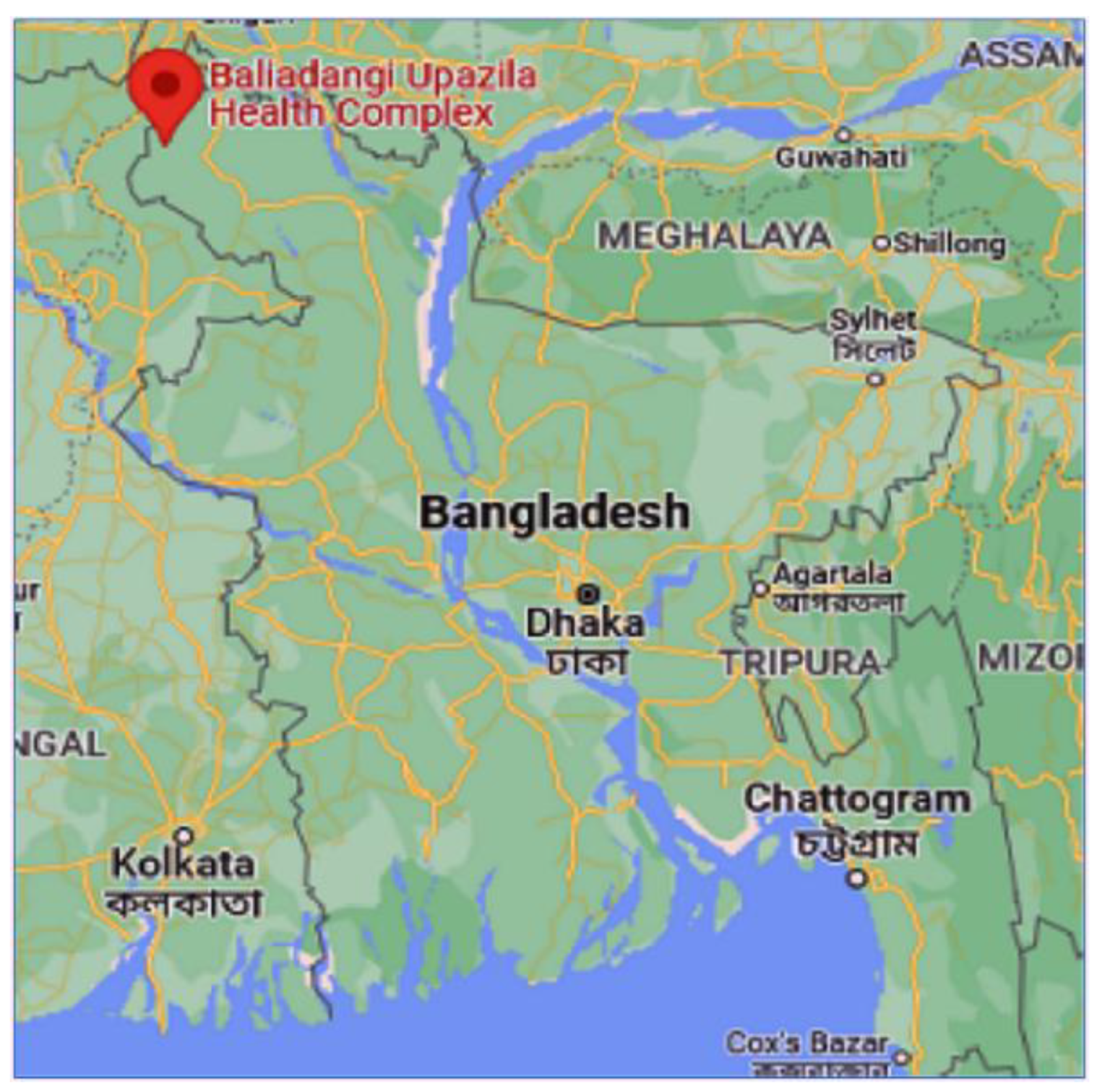
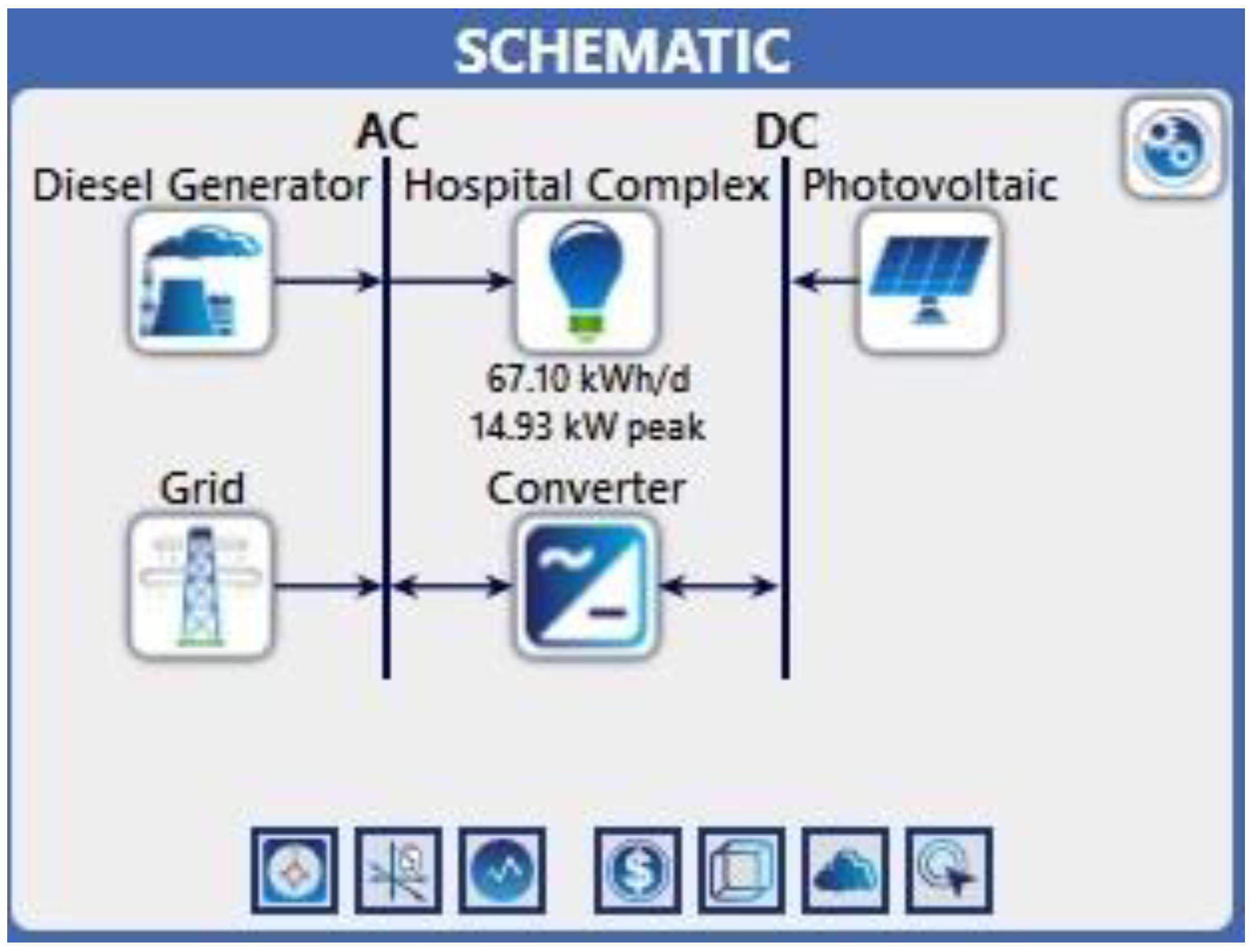
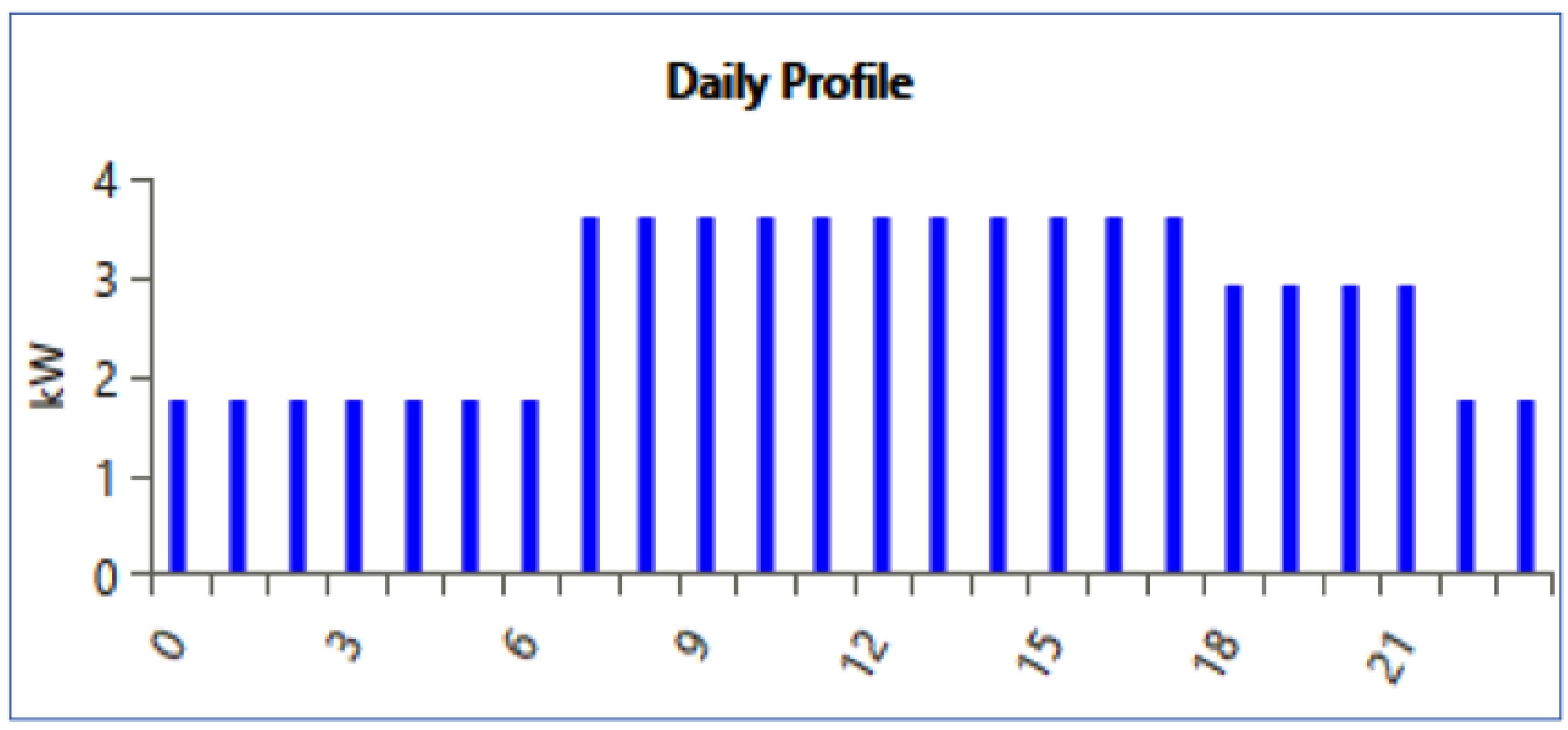

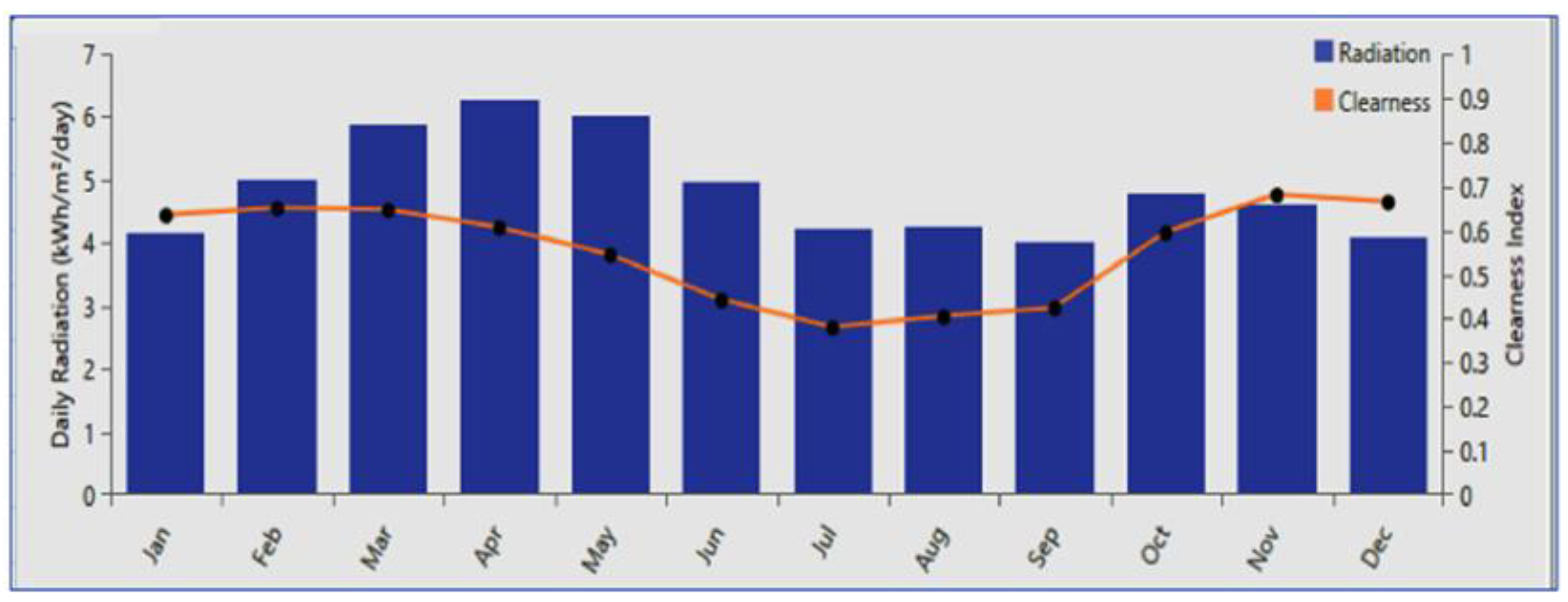
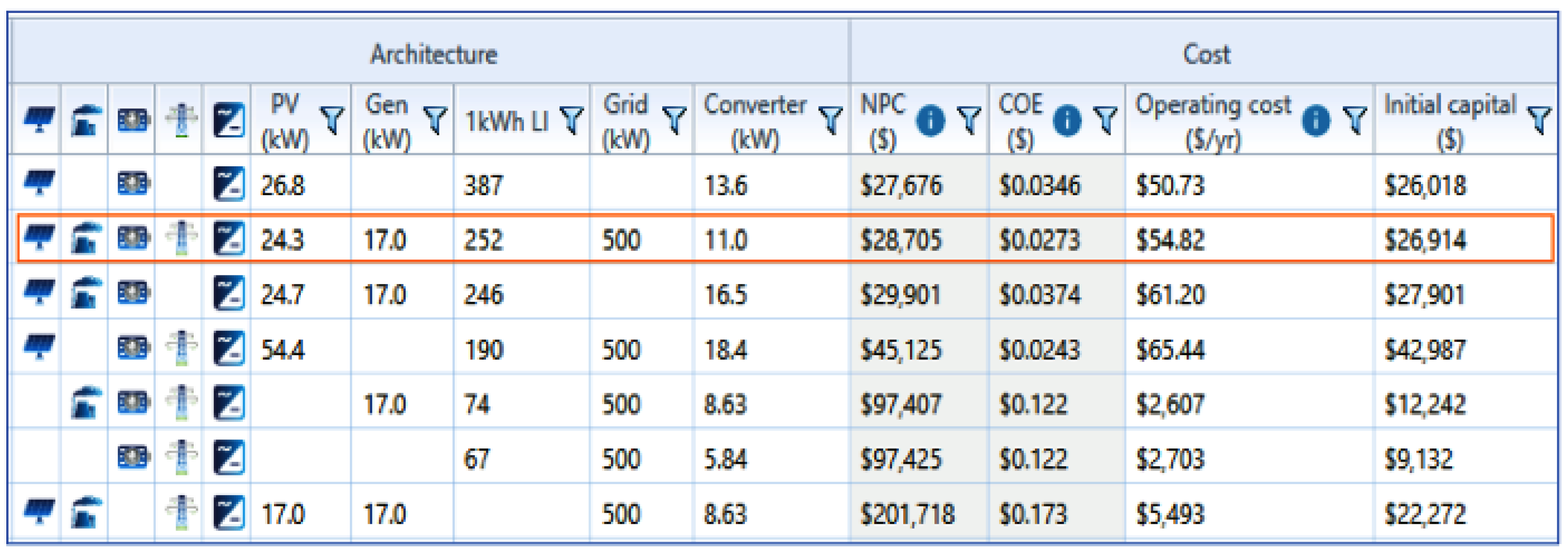
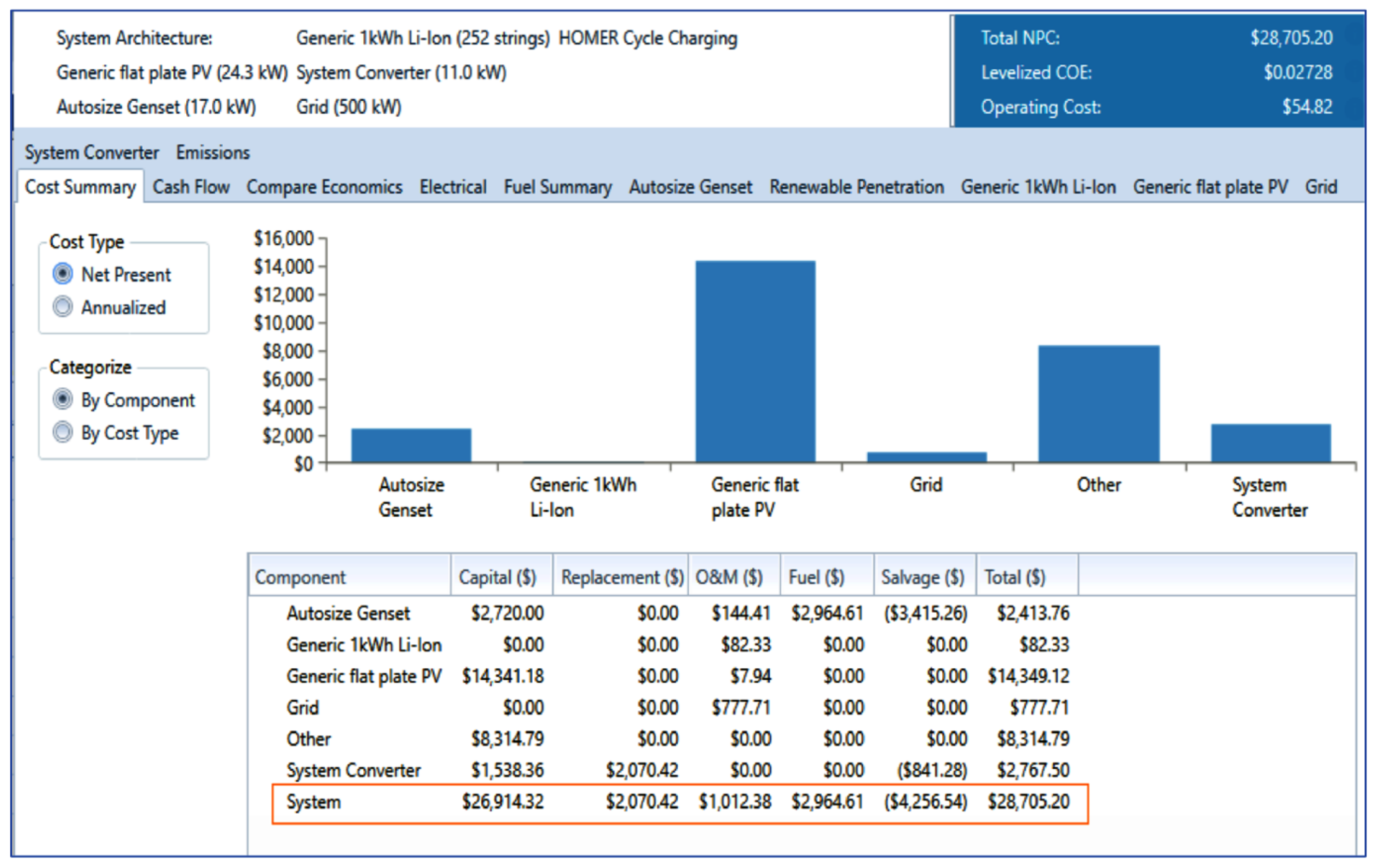
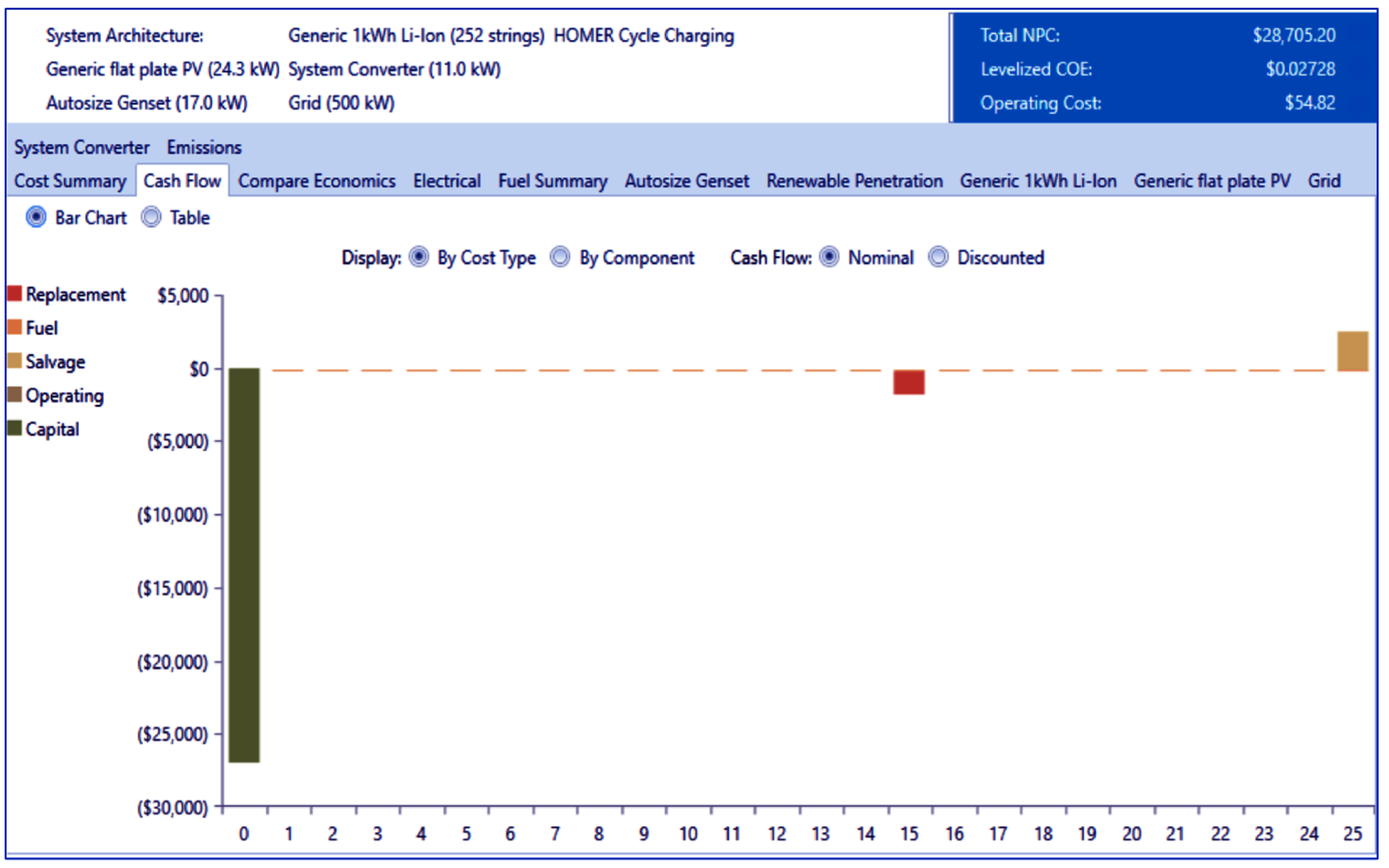
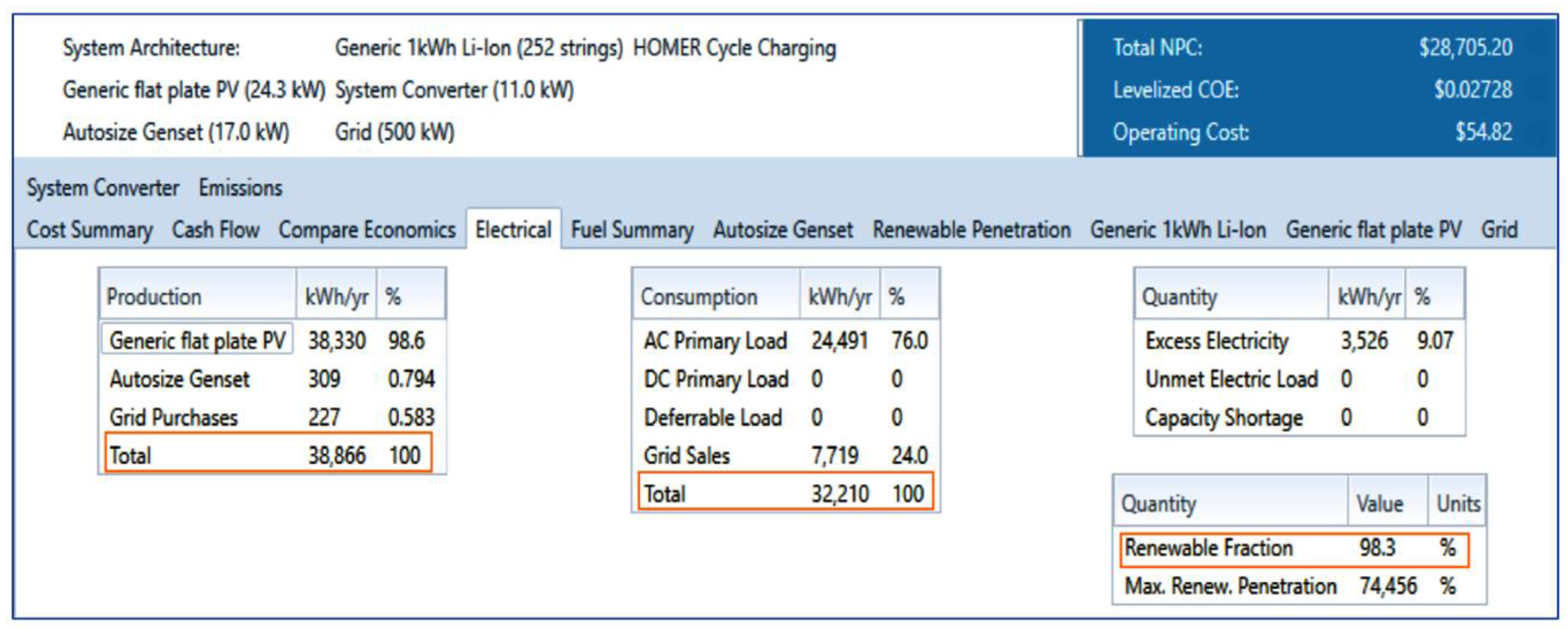
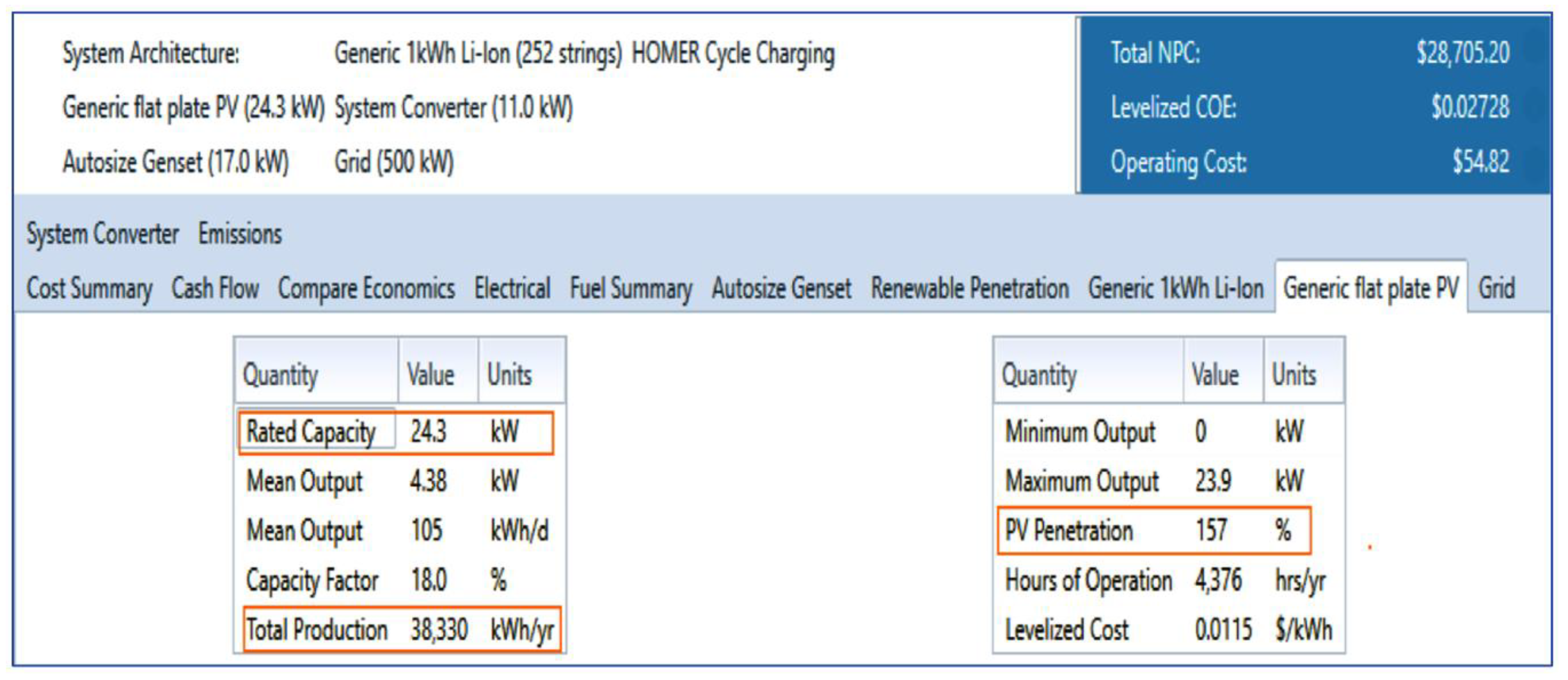

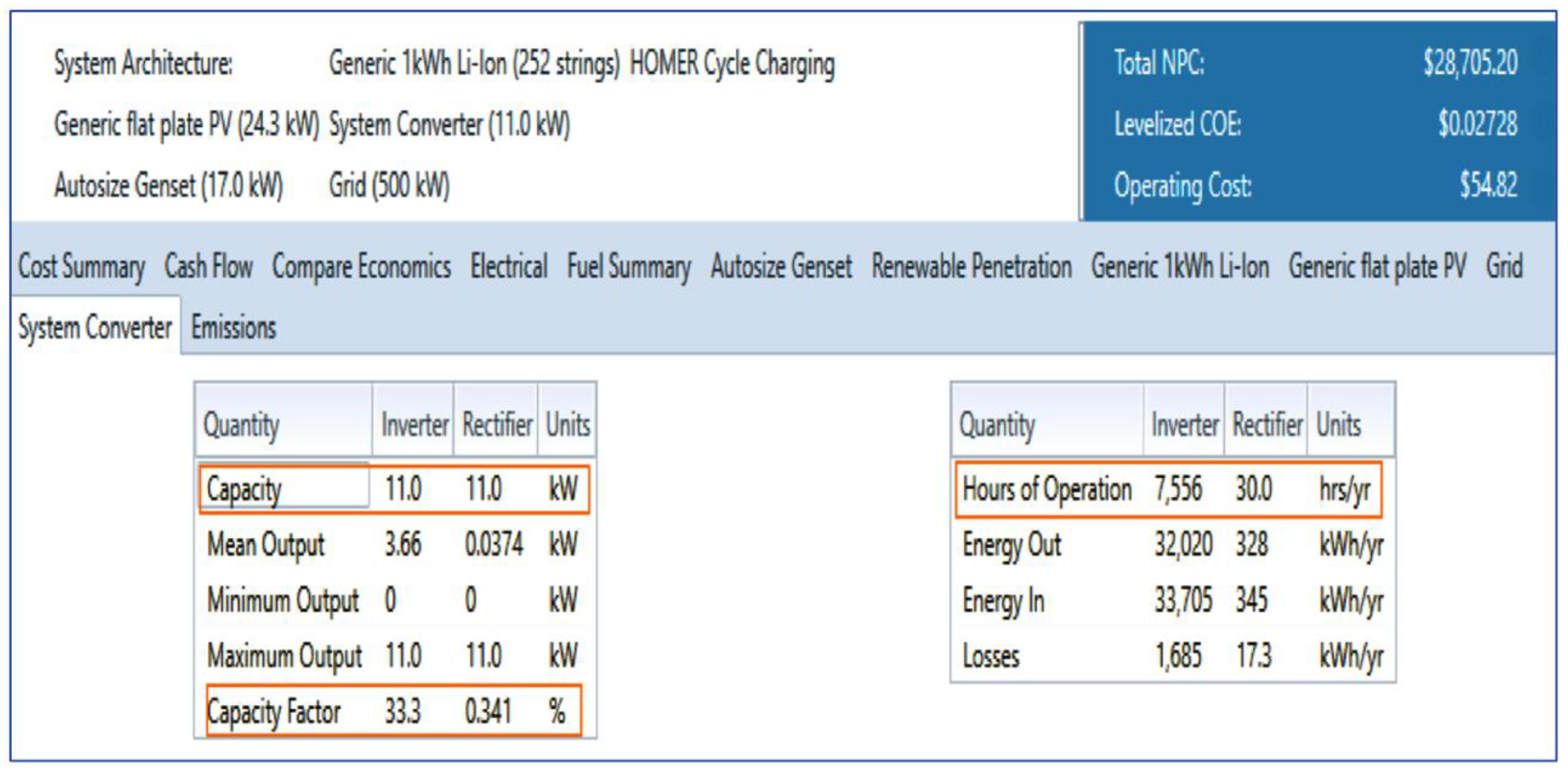
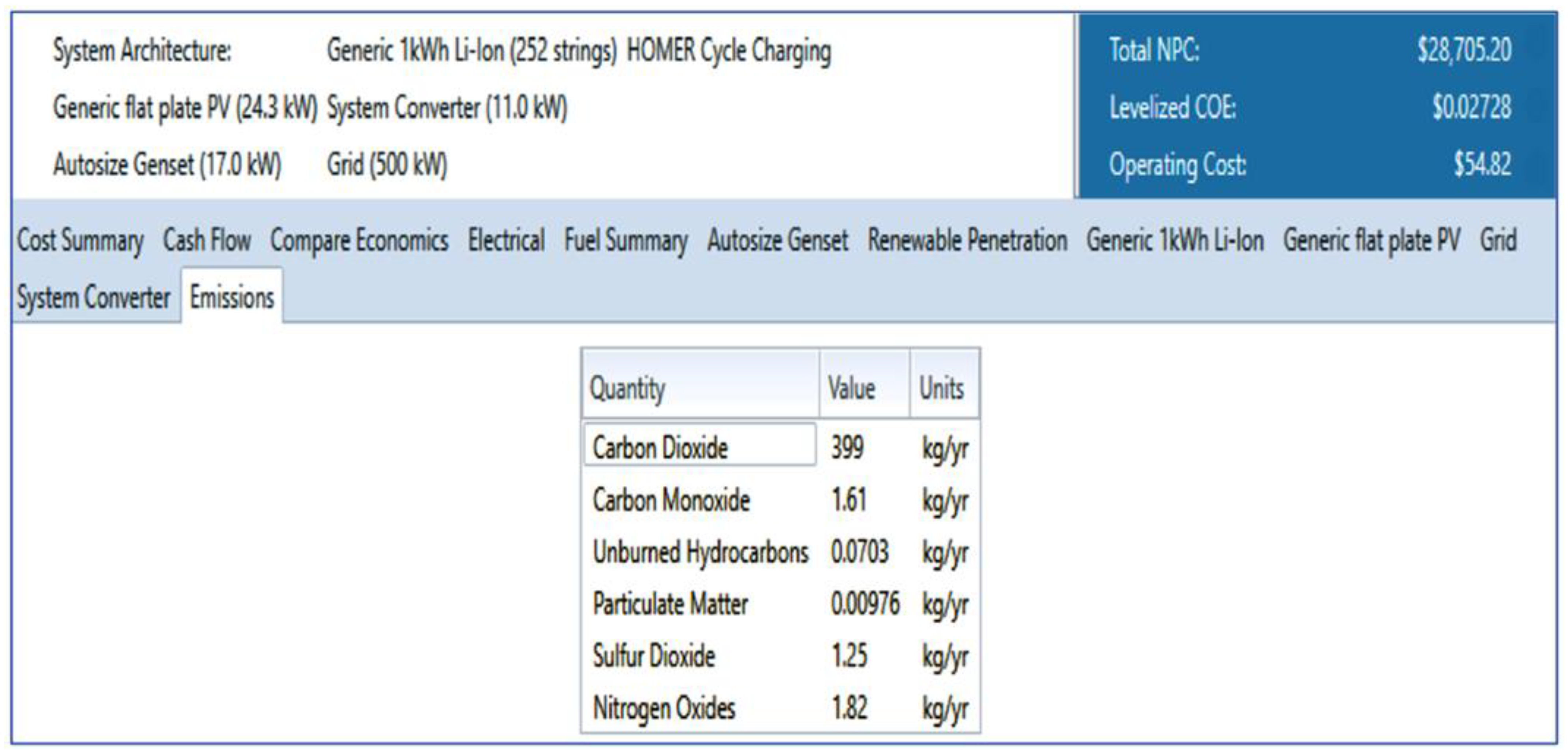
| Parameters | Specification |
|---|---|
| Maximum Power | 400 Wp |
| Maximum power voltage | 41.7 V |
| Maximum power current | 9.60 A |
| Open circuit voltage | 49.8 V |
| Short circuit current | 10.36 A |
| Module Efficiency STC (%) | 19.88% |
| Operating Temperature | −40 °C~+85 °C |
| Nominal Operating Cell Temperature (NOCT) | 45 ± 2 °C |
| Dimensions | 2008 × 1002 × 40 mm |
| Warranty | 25 years |
| Tracking system | Fixed |
| Component | PV Panel | Converter | Diesel Generator |
|---|---|---|---|
| Size/Type | 24 kW | 11 kW | 17 kW |
| Capital Cost ($) | 590/kW | 140/kW | 160/kW |
| Replacement Cost ($) | 531/kW | 140/kW | 128 |
| O&M Cost ($) | 0.01/Year | 0 | 0.010 |
| Lifetime | 25.00 Years | 15 Years | 15,000.00 h |
| Derating factor (%) | 80.00 | - | - |
| Load Description | Q | P | X = Q × P | Y | E = (X × Y)/1000 |
|---|---|---|---|---|---|
| Quantity | Power (W) | Total Power (W) | On-Time (h/d) | Total Energy (kWh/Day) | |
| Vaccine Refrigerator | 5 | 60 | 300 | 24 | 7.2 |
| Light | 128 | 20 | 2560 | 6 | 15.3 |
| Sterilization Equipment | 3 | 1400 | 4200 | 0.5 | 2.1 |
| Suction | 5 | 80 | 400 | 0.5 | 0.2 |
| Water Heater | 1 | 1000 | 1000 | 0.5 | 0.5 |
| Ceiling Fan | 32 | 50 | 1600 | 6 | 9.6 |
| Incubator | 1 | 200 | 200 | 2 | 0.4 |
| TV | 2 | 70 | 140 | 5 | 0.7 |
| Refrigerator | 3 | 100 | 300 | 24 | 7.2 |
| Centrifuge | 2 | 40 | 80 | 0.5 | 0.1 |
| Microscopes | 4 | 30 | 120 | 2 | 0.1 |
| Laptop | 2 | 60 | 120 | 4 | 0.5 |
| Hematology Analyzer | 3 | 60 | 180 | 3 | 0.5 |
| Computer Desktop | 11 | 100 | 1100 | 3 | 3.3 |
| Printer | 8 | 100 | 800 | 2 | 1.6 |
| Exhaust Fan | 2 | 40 | 80 | 7 | 0.5 |
| Air Conditioner | 2 | 1000 | 2000 | 3 | 6 |
| Surgery Spotlight | 3 | 150 | 450 | 3 | 1.3 |
| Ventilator | 1 | 150 | 150 | 3 | 0.4 |
| Anaesthetic machine | 1 | 100 | 100 | 3 | 0.3 |
| Genexpert | 1 | 190 | 190 | 2 | 0.3 |
| Cautery Diathermy | 1 | 100 | 100 | 2 | 0.2 |
| Pulse Oximeter | 3 | 30 | 90 | 3 | 0.1 |
| X-ray Machine | 1 | 1500 | 1000 | 2 | 2 |
| Water Pump | 1 | 2238 | 2238 | 3 | 6.7 |
| Total | 19,372 | 67.1 |
Disclaimer/Publisher’s Note: The statements, opinions and data contained in all publications are solely those of the individual author(s) and contributor(s) and not of MDPI and/or the editor(s). MDPI and/or the editor(s) disclaim responsibility for any injury to people or property resulting from any ideas, methods, instructions or products referred to in the content. |
© 2023 by the authors. Licensee MDPI, Basel, Switzerland. This article is an open access article distributed under the terms and conditions of the Creative Commons Attribution (CC BY) license (https://creativecommons.org/licenses/by/4.0/).
Share and Cite
Ahmed, P.; Rahman, M.F.; Haque, A.K.M.M.; Mohammed, M.K.A.; Toki, G.F.I.; Ali, M.H.; Kuddus, A.; Rubel, M.H.K.; Hossain, M.K. Feasibility and Techno-Economic Evaluation of Hybrid Photovoltaic System: A Rural Healthcare Center in Bangladesh. Sustainability 2023, 15, 1362. https://doi.org/10.3390/su15021362
Ahmed P, Rahman MF, Haque AKMM, Mohammed MKA, Toki GFI, Ali MH, Kuddus A, Rubel MHK, Hossain MK. Feasibility and Techno-Economic Evaluation of Hybrid Photovoltaic System: A Rural Healthcare Center in Bangladesh. Sustainability. 2023; 15(2):1362. https://doi.org/10.3390/su15021362
Chicago/Turabian StyleAhmed, Polash, Md. Ferdous Rahman, A. K. M. Mahmudul Haque, Mustafa K. A. Mohammed, G. F. Ishraque Toki, Md. Hasan Ali, Abdul Kuddus, M. H. K. Rubel, and M. Khalid Hossain. 2023. "Feasibility and Techno-Economic Evaluation of Hybrid Photovoltaic System: A Rural Healthcare Center in Bangladesh" Sustainability 15, no. 2: 1362. https://doi.org/10.3390/su15021362
APA StyleAhmed, P., Rahman, M. F., Haque, A. K. M. M., Mohammed, M. K. A., Toki, G. F. I., Ali, M. H., Kuddus, A., Rubel, M. H. K., & Hossain, M. K. (2023). Feasibility and Techno-Economic Evaluation of Hybrid Photovoltaic System: A Rural Healthcare Center in Bangladesh. Sustainability, 15(2), 1362. https://doi.org/10.3390/su15021362














